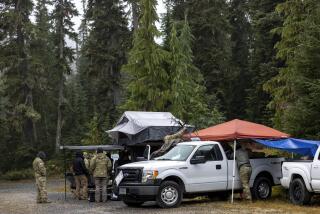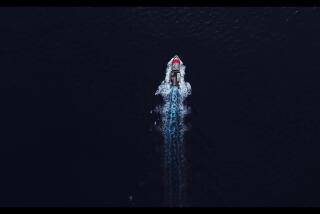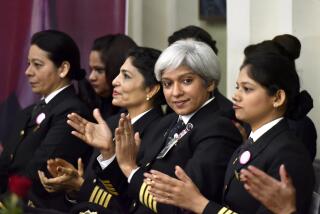Female Pilots at Mudd Recall Their Exploits
CLAREMONT — Pioneer aviator Fay Gillis Wells was at Harvey Mudd College last week, talking about how in 1929 she became the first female member of the Caterpillar Club, open only to those who parachute from an airplane in distress.
“My instructor asked me if I’d like to try aerobatics, after I’d been flying three weeks,” said Wells, who counts President Bush as a fellow Caterpillar Club member.
“When we were upside down, the plane began to vibrate and then some tail and wing sections disintegrated. I bailed out and landed in a tree--without a scratch. But he was put into an ambulance and, after heading for the hospital, it was hit by a car. Meanwhile, they rushed me back to the airport to fly again, so I’d get rid of the fear.”
The mystery of a lost trophy and the mystique of a round-the-world flight were a bond for a group of female pilots who gathered for a meeting at the college in Claremont.
Search for Lost Trophy
Wells was in California to search for a lost trophy given to female aviators each year. The Claremont meeting was suggested by Luanne Paul King of Pasadena, a pilot, educator and writer with whom Wells stayed in Southern California.
Iris Critchell of Claremont, veteran pilot and co-founder with her husband, Howard, of Mudd’s unique Isabel Bates Aeronautics Program, got together a group of Mudd students and faculty to meet Wells in the college library. In the Bates program, flying is taught to science and engineering students, not as a sport or technological discipline, but “to add a new level of self-mastery in learning” and “enhance the whole education and development of the individual young person through the privilege of flight,” according to a brochure.
At the gathering, Critchell also reported on the progress of her friend, Gaby Kennard, an Australian who is flying solo around the world. Kennard was making a crucial crossing of the South Atlantic at that point, and later was reported safe on terra firma at Dakar, the capital of Senegal on the West African coast, where she was to rest briefly before the final part of her journey back to Sydney.
Earhart’s Route
Kennard is retracing approximately the equatorial route along which aviation pioneer Amelia Earhart disappeared in 1937.
Wells, who will turn 81 this month, told of other exploits in the air, as well as in journalism. They varied from Africa, where her son was born while she and her husband covered the Italo-Ethiopian war, to the Soviet Union, where she once spent 19 days flying from Moscow to Tashkent, “because we had to make 40 forced landings.”
But she wouldn’t trade those interruptions for anything, she said, because they offered incomparable opportunities to fraternize with Russians. “Routine stops wouldn’t have been permitted then,” she said, “But an emergency? Hey, roll out the vodka!”
Breaking News
She was in China in 1934 to cover the coronation of Pu Yi (“The Last Emperor”) and again with President Nixon when he reopened relations with Beijing in 1972.
She was one of the founders, with Amelia Earhart and others, of the Ninety Nines, an international association of women pilots, and was the main force behind creation of the organization’s International Forest of Friendship, in Atchison, Kan.
In recent years, Wells has been trying to find out what happened to one of the Harmon Trophies. The Clifford B. Harmon International Trophies were established in 1926 and given annually for outstanding achievement by male and female aviators or by aeronauts (balloonists).
However, the female aviator trophy has somehow been lost and the trail led Wells not only to the Mudd library but also to a woman in Agoura whose late father was a key Harmon trustee and to the last two women who won the award, both residing in Southern California.
One of them, Janice Brown of Bakersfield, the Harmon winner in 1981, told Wells she never saw the trophy itself. “I just got a plaque,” she said. She won it for flying the first solar-powered airplanes designed by Paul MacCready of Pasadena.
More to Read
Sign up for Essential California
The most important California stories and recommendations in your inbox every morning.
You may occasionally receive promotional content from the Los Angeles Times.










